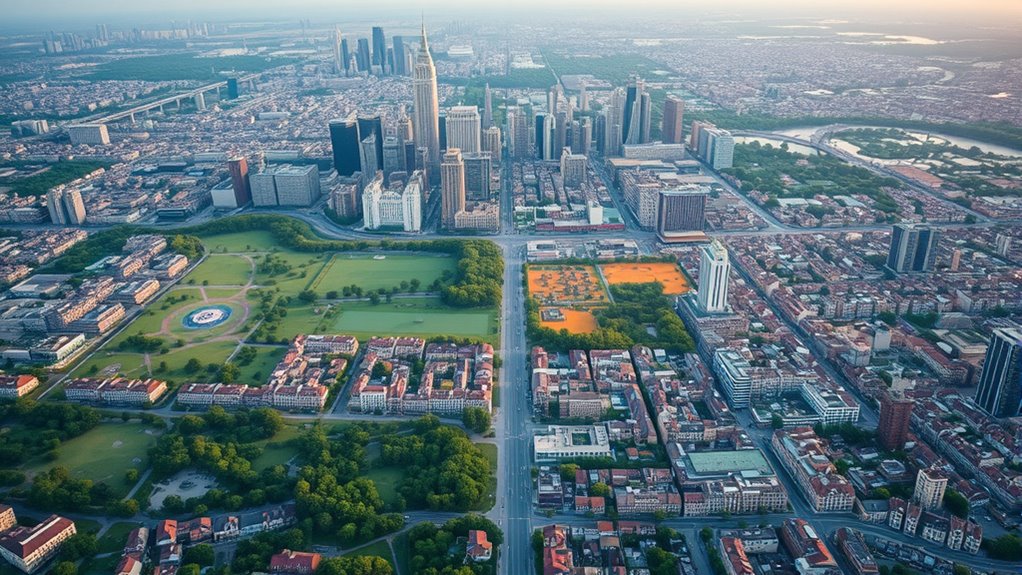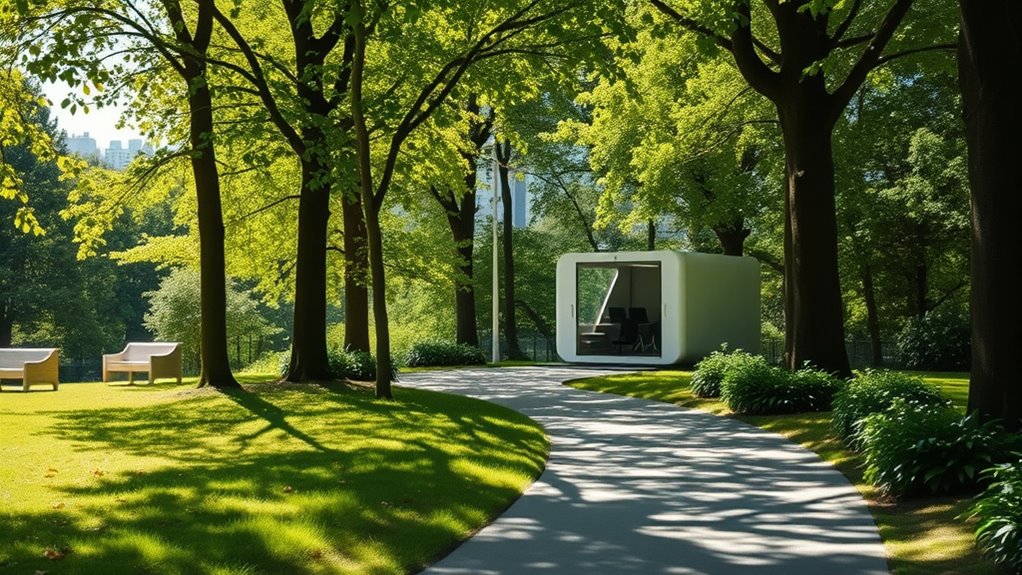Environmental noise mapping helps you locate the quietest places to work by visualizing sound levels across urban areas. It highlights low-noise zones like parks, green spaces, or sound-shielded buildings, so you can choose a location away from busy streets or construction. Using tools like noise maps and apps, you can identify and create the perfect, peaceful workspace. Keep exploring to discover how technology can help you find and maintain your ideal quiet environment.
Key Takeaways
- Use noise maps to identify areas with low sound levels and minimal urban noise pollution.
- Analyze real-time sound data to find consistent quiet zones suitable for focused work.
- Utilize environmental noise visualization tools to locate parks, green spaces, or sound-shielded buildings.
- Implement sensor technology and automation to monitor and maintain optimal noise levels continuously.
- Prioritize locations away from busy streets or construction sites to enhance productivity and well-being.
Understanding Environmental Noise Mapping

Environmental noise mapping is a crucial tool for understanding how sound affects communities and ecosystems. It helps you visualize urban soundscapes, revealing the distribution and intensity of noise across different areas. By analyzing these maps, you gain insight into how noise pollution impacts daily life and natural habitats. Acoustic ecology plays a vital role in this process, focusing on the relationship between sound and the environment. With detailed noise maps, you can identify hotspots of excessive noise, assess how urban development influences sound levels, and plan for quieter, healthier spaces. This understanding is essential for creating balanced environments where human activity and nature coexist harmoniously, improving quality of life and preserving ecological integrity. Additionally, considering the side effects of noise pollution, such as stress and sleep disturbances, is important for managing urban soundscapes effectively.
The Benefits of Identifying Quiet Work Spaces

Identifying quiet work spaces offers significant advantages for productivity and well-being. When you find areas with minimal noise, you can focus better, reduce stress, and boost efficiency. Using soundproofing techniques and implementing acoustic zoning helps create these ideal environments, whether at home or in an office. Quiet zones minimize distractions, leading to clearer thinking and improved task performance. Additionally, dedicated quiet spaces promote mental health by decreasing noise-related fatigue. By consciously selecting and designing these areas, you guarantee a more comfortable and productive work experience. Color accuracy and contrast ratio are crucial factors in creating an optimal environment, as they influence perception and comfort during work or leisure activities.
How Noise Data Is Collected and Analyzed

To accurately assess noise levels, data collection involves deploying specialized sound monitoring devices in targeted areas. These noise sensors record sound intensity over specific periods, capturing fluctuations throughout different times of the day. Once collected, this data is processed and analyzed to identify patterns and sources of noise. Advanced tools help visualize the data through clear data visualization techniques, making it easier to interpret complex sound information. By mapping the noise levels spatially and temporally, you can pinpoint quieter zones ideal for work or relaxation. Proper analysis of this data enables you to make informed decisions about choosing ideal environments, ensuring you avoid noisy areas and find spaces that support focus and productivity. Incorporating powerful persuasive words can further enhance your ability to communicate findings effectively and advocate for optimal work environments.
Using Noise Maps to Find Your Perfect Work Spot

Noise maps serve as practical tools for locating ideal work environments by visually representing sound levels across different areas. By analyzing urban soundscapes, you can identify quieter zones that minimize noise pollution, helping you find a peaceful workspace. These maps highlight areas with low ambient noise, free from traffic, construction, or crowd chatter, so you can optimize your productivity. Additionally, understanding sound level measurements can help you interpret the data more accurately to select the best location.
Noise maps help identify quiet, productive workspaces away from urban noise pollution.
Consider these factors:
- Locations away from busy streets
- Parks or green spaces with natural sounds
- Buildings shielded from major noise sources
- Corners or indoor spots with sound barriers
- Areas with consistent low noise levels, even during peak hours
Using noise maps, you gain a clear picture of where to settle for a quiet, focused work environment, free from the disruptions of urban noise pollution.
Tools and Apps for Noise Monitoring

Have you ever wondered how to accurately measure sound levels in your environment? Today’s tools and apps make it easy to monitor urban soundscapes and identify noise pollution. Smartphone apps like Decibel X and Sound Meter provide real-time noise level readings, helping you assess whether an area is suitable for work. Dedicated devices, such as the NoiseCapture app or handheld sound level meters, offer more precise data for detailed analysis. These tools often include features like data logging and geotagging, so you can map noise levels across different locations. By using these apps and devices, you gain a clearer understanding of your environment’s soundscape, enabling you to choose quieter zones for better focus and well-being.
Practical Tips for Creating a Calm Work Environment

Using noise monitoring tools helps you identify areas with high sound levels, so you can take targeted steps to create a calmer workspace. Implement soundproofing techniques such as installing acoustic panels, weather stripping doors, or adding thick rugs to absorb noise. Prioritize ergonomic design by arranging your furniture to minimize distractions and guarantee comfort. Keep electronic devices away from your main work zone to reduce background noise. Use white noise machines or calming background sounds to mask disruptive noises. Consider creating quiet zones or designated areas for focused work. Additionally, incorporate soft furnishings and plants to naturally dampen sound and improve air quality. Incorporating soundproofing materials can significantly enhance your environment, boosting productivity and reducing stress.
Future Trends in Noise Management and Remote Work

As remote work becomes more common, your acoustic needs will evolve to prioritize personal noise control. Smart technologies are emerging to automatically manage sound levels and create a quieter home environment. Staying aware of these advancements can help you adapt and optimize your space for better focus and comfort. Incorporating modern trends in tableware such as eco-friendly materials and customizable designs can also enhance your overall living and working experience.
Remote Work Acoustic Needs
With remote work becoming increasingly prevalent, addressing acoustic needs at home is more important than ever. You need a quiet environment to stay focused and productive. Future trends include personalized sound masking solutions that block out distractions and create a consistent background noise. Acoustic treatment, like installing soundproof panels or rugs, helps reduce external noise and echoes. Smart audio systems will adapt to your environment, optimizing sound quality automatically. Additionally, portable noise-canceling devices are becoming more sophisticated, giving you control on the go. These innovations aim to tailor your workspace to your acoustic preferences, boosting efficiency and comfort. Diverse designs of soundproofing materials and furnishings can complement your existing decor while enhancing soundproofing capabilities.
Smart Noise Control Technologies
Smart noise control technologies are transforming remote work environments by providing dynamic, adaptive solutions that respond to your changing needs. With advanced noise cancellation systems, you can block out distracting sounds instantly, creating a more focused workspace. Modern soundproofing techniques, such as intelligent materials and adjustable barriers, help reduce noise infiltration effectively. These innovations allow your environment to adapt in real-time, whether you’re on a conference call or deep into work. Smart noise control devices learn from your surroundings, automatically adjusting to optimize sound levels. This integration of technology ensures your space remains quiet and productive without requiring constant manual adjustments. As these smart solutions evolve, they’ll become essential tools for creating personalized, disturbance-free remote work zones. Additionally, incorporating soundproofing techniques inspired by the unique features of certain dog breeds can enhance the effectiveness of noise mitigation strategies.
Frequently Asked Questions
How Accurate Are Current Noise Mapping Technologies?
Current noise mapping technologies are quite advanced but their accuracy depends on the quality of noise sensors used. You rely on data accuracy from these sensors to identify your ideal work zone. In practice, high-quality sensors provide more precise readings, helping you make better decisions. However, environmental factors and sensor calibration can influence results, so always guarantee your noise sensors are well-maintained for the most reliable data.
Can Noise Maps Predict Future Noise Pollution?
You might wonder if noise maps can predict future noise pollution. While noise forecasting improves with recent data and modeling, it’s not perfect. It considers urban soundscapes and trends but can’t fully anticipate unexpected events or changes. These maps help you understand potential future noise levels, enabling better planning. So, they offer valuable insights, but always remember, actual conditions may differ due to dynamic urban environments.
Are There Legal Limits for Acceptable Noise Levels in Work Zones?
You might think legal standards for noise levels in work zones vary widely, but in reality, many regions have strict noise regulation laws. These legal standards set acceptable noise limits to protect workers and nearby communities. It is crucial to check local regulations, as exceeding these limits can lead to penalties. Understanding these legal standards helps you create a safer, more compliant work environment and minimizes noise-related disputes.
How Often Should Noise Maps Be Updated for Reliability?
You should update noise maps regularly to guarantee reliability and effective noise mitigation. Typically, updating every 1 to 3 years is recommended, but if there are significant changes in the work zone or new noise sources, more frequent updates are necessary. This helps maintain mapping accuracy, allowing you to identify noise hotspots promptly and implement appropriate mitigation measures, ultimately creating a more comfortable and compliant work environment.
Can Individual Preferences Influence Optimal Noise Levels?
Like a melody shaped by your unique tune, personal preferences influence your ideal noise level. Your sense of comfort dances with cultural perceptions, turning a simple soundscape into a canvas of relaxation or distraction. You naturally seek a harmony that suits your mood, making noise levels more than just decibels. Embracing your personal comfort, you can craft a workspace that feels just right, tuned perfectly to your individual rhythm.
Conclusion
By exploring environmental noise maps, you open the door to discovering peaceful work spots that boost your focus and well-being. Embrace the tools and tips available to craft a calmer workspace, even amid bustling surroundings. As technology advances, finding your ideal nook becomes easier, turning everyday noise into a subtle background hum. So, take charge of your environment and let quiet moments become your secret weapon for productivity and peace.









